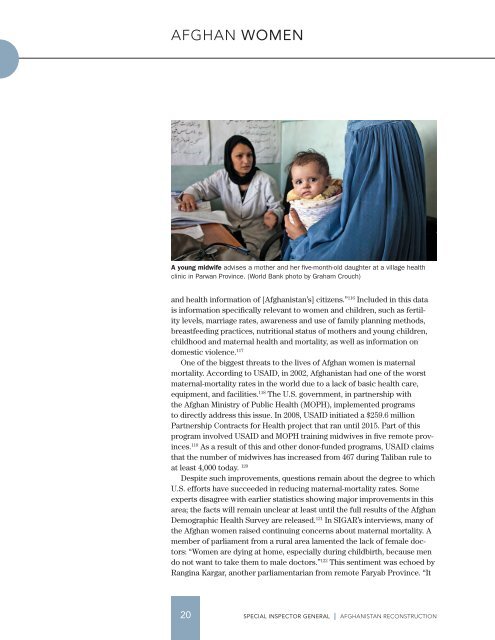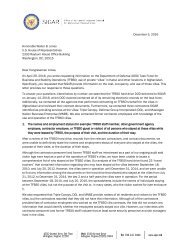- Page 1 and 2: SIGAR OCT Special Inspector General
- Page 3 and 4: SPECIAL INSPECTOR GENERAL FOR AFGHA
- Page 5 and 6: This quarter, SIGAR published an al
- Page 7 and 8: EXECUTIVE SUMMARY • Two inquiries
- Page 9 and 10: TABLE OF CONTENTS SECTION 4 211 OTH
- Page 11 and 12: 1AFGHAN WOMEN DISCUSS PROGRESS AND
- Page 13 and 14: AFGHAN WOMEN NO SURRENDER: AFGHAN W
- Page 15 and 16: AFGHAN WOMEN Women gather in Sheber
- Page 17 and 18: AFGHAN WOMEN REFORMS HAVE HISTORICA
- Page 19 and 20: AFGHAN WOMEN Basira Basiratkha, pri
- Page 21 and 22: AFGHAN WOMEN PROMOTE In Afghanistan
- Page 23 and 24: AFGHAN WOMEN Afghan policewomen par
- Page 25 and 26: AFGHAN WOMEN Violence against women
- Page 27 and 28: AFGHAN WOMEN Female cabinet members
- Page 29: AFGHAN WOMEN Many of the women SIGA
- Page 33 and 34: AFGHAN WOMEN An Afghan girl reads a
- Page 35 and 36: AFGHAN WOMEN teachers, and the hara
- Page 37 and 38: 2 SIGAR OVERSIGHT 27
- Page 39 and 40: SIGAR OVERSIGHT ACTIVITIES SIGAR OV
- Page 41 and 42: SIGAR OVERSIGHT ACTIVITIES Council
- Page 43 and 44: SIGAR OVERSIGHT ACTIVITIES specific
- Page 45 and 46: SIGAR OVERSIGHT ACTIVITIES in Afgha
- Page 47 and 48: SIGAR OVERSIGHT ACTIVITIES and repo
- Page 49 and 50: SIGAR OVERSIGHT ACTIVITIES of under
- Page 51 and 52: SIGAR OVERSIGHT ACTIVITIES A list o
- Page 53 and 54: SIGAR OVERSIGHT ACTIVITIES to suppo
- Page 55 and 56: SIGAR OVERSIGHT ACTIVITIES $610 and
- Page 57 and 58: SIGAR OVERSIGHT ACTIVITIES The purp
- Page 59 and 60: SIGAR OVERSIGHT ACTIVITIES Construc
- Page 61 and 62: SIGAR OVERSIGHT ACTIVITIES Corporat
- Page 63 and 64: SIGAR OVERSIGHT ACTIVITIES parties
- Page 65 and 66: SIGAR OVERSIGHT ACTIVITIES Inspecti
- Page 67 and 68: SIGAR OVERSIGHT ACTIVITIES closed o
- Page 69 and 70: SIGAR OVERSIGHT ACTIVITIES and judg
- Page 71 and 72: SIGAR OVERSIGHT ACTIVITIES findings
- Page 73 and 74: SIGAR OVERSIGHT ACTIVITIES food ass
- Page 75 and 76: SIGAR OVERSIGHT ACTIVITIES 5. U.S.
- Page 77 and 78: SIGAR OVERSIGHT ACTIVITIES longer-t
- Page 79 and 80: SIGAR OVERSIGHT ACTIVITIES Simon Da
- Page 81 and 82:
SIGAR OVERSIGHT ACTIVITIES Kabul. T
- Page 83 and 84:
SIGAR OVERSIGHT ACTIVITIES environm
- Page 85 and 86:
SIGAR OVERSIGHT ACTIVITIES found th
- Page 87 and 88:
SIGAR OVERSIGHT ACTIVITIES SIGAR’
- Page 89 and 90:
3RECONSTRUCTION UPDATE 79
- Page 91 and 92:
RECONSTRUCTION UPDATE RECONSTRUCTIO
- Page 93 and 94:
RECONSTRUCTION UPDATE The U.S. has
- Page 95 and 96:
STATUS OF FUNDS STATUS OF FUNDS To
- Page 97 and 98:
STATUS OF FUNDS The United States a
- Page 99 and 100:
STATUS OF FUNDS Congress appropriat
- Page 101 and 102:
STATUS OF FUNDS ASFF BUDGET ACTIVIT
- Page 103 and 104:
STATUS OF FUNDS USAID INCLE State A
- Page 105 and 106:
DOD STATUS OF FUNDS CERP DOD DOD DR
- Page 107 and 108:
DOD STATUS OF FUNDS ESF USAID INTER
- Page 109 and 110:
STATUS OF FUNDS the United Kingdom
- Page 111 and 112:
SECURITY SECURITY As of September 3
- Page 113 and 114:
SECURITY improvised-explosive devic
- Page 115 and 116:
SECURITY TABLE 3.6 DISTRICT CONTROL
- Page 117 and 118:
SECURITY locations that previously
- Page 119 and 120:
SECURITY TABLE 3.7 ANDSF ASSIGNED F
- Page 121 and 122:
SECURITY ANDSF CONTINUE TO RELY ON
- Page 123 and 124:
SECURITY General Joseph F. Dunford
- Page 125 and 126:
SECURITY ANA Military Personnel Dec
- Page 127 and 128:
SECURITY Other reasons included pri
- Page 129 and 130:
SECURITY After accounting for equip
- Page 131 and 132:
SECURITY International Airport. 415
- Page 133 and 134:
SECURITY Afghan Air Force pilots fl
- Page 135 and 136:
SECURITY ordnance, information tech
- Page 137 and 138:
SECURITY women at the Regional Trai
- Page 139 and 140:
SECURITY This quarter RS reported t
- Page 141 and 142:
SECURITY TABLE 3.12 CONVENTIONAL-WE
- Page 143 and 144:
SECURITY FIGURE 3.27 AFGHAN OPIUM C
- Page 145 and 146:
SECURITY For clients who have a sho
- Page 147 and 148:
SECURITY FIGURE 3.28 GOVERNOR-LED O
- Page 149 and 150:
SECURITY with INL. 544 KFZ is desig
- Page 151 and 152:
SECURITY RADP-West’s key accompli
- Page 153 and 154:
SECURITY counternarcotics agencies.
- Page 155 and 156:
SECURITY SIU. The arrival of a Reso
- Page 157 and 158:
GOVERNANCE GOVERNANCE As of Septemb
- Page 159 and 160:
GOVERNANCE and integrity of public
- Page 161 and 162:
GOVERNANCE not yet passed a new ele
- Page 163 and 164:
GOVERNANCE United States continue t
- Page 165 and 166:
GOVERNANCE MOD and MOI Generally Me
- Page 167 and 168:
GOVERNANCE December 2016. As of Sep
- Page 169 and 170:
GOVERNANCE personnel, make cash or
- Page 171 and 172:
GOVERNANCE honorary designation in
- Page 173 and 174:
GOVERNANCE Anti-Corruption Monitori
- Page 175 and 176:
GOVERNANCE from President Ghani and
- Page 177 and 178:
GOVERNANCE Between March 2015 and M
- Page 179 and 180:
GOVERNANCE Of the various MOD antic
- Page 181 and 182:
GOVERNANCE 2016. OCHA reported in A
- Page 183 and 184:
GOVERNANCE employers. These graduat
- Page 185 and 186:
ECONOMIC AND SOCIAL DEVELOPMENT ECO
- Page 187 and 188:
ECONOMIC AND SOCIAL DEVELOPMENT The
- Page 189 and 190:
ECONOMIC AND SOCIAL DEVELOPMENT adm
- Page 191 and 192:
ECONOMIC AND SOCIAL DEVELOPMENT Cus
- Page 193 and 194:
ECONOMIC AND SOCIAL DEVELOPMENT Exp
- Page 195 and 196:
ECONOMIC AND SOCIAL DEVELOPMENT pos
- Page 197 and 198:
ECONOMIC AND SOCIAL DEVELOPMENT FIG
- Page 199 and 200:
ECONOMIC AND SOCIAL DEVELOPMENT Min
- Page 201 and 202:
ECONOMIC AND SOCIAL DEVELOPMENT stu
- Page 203 and 204:
ECONOMIC AND SOCIAL DEVELOPMENT Ope
- Page 205 and 206:
ECONOMIC AND SOCIAL DEVELOPMENT TAB
- Page 207 and 208:
ECONOMIC AND SOCIAL DEVELOPMENT and
- Page 209 and 210:
ECONOMIC AND SOCIAL DEVELOPMENT tra
- Page 211 and 212:
ECONOMIC AND SOCIAL DEVELOPMENT TAB
- Page 213 and 214:
ECONOMIC AND SOCIAL DEVELOPMENT Afg
- Page 215 and 216:
ECONOMIC AND SOCIAL DEVELOPMENT fun
- Page 217 and 218:
ECONOMIC AND SOCIAL DEVELOPMENT emp
- Page 219:
ECONOMIC AND SOCIAL DEVELOPMENT A c
- Page 222 and 223:
OTHER AGENCY OVERSIGHT CONTENTS OTH
- Page 224 and 225:
OTHER AGENCY OVERSIGHT TABLE 4.1 (C
- Page 226 and 227:
OTHER AGENCY OVERSIGHT Duplication
- Page 228 and 229:
OTHER AGENCY OVERSIGHT it has or ha
- Page 230 and 231:
OTHER AGENCY OVERSIGHT subordinate
- Page 232 and 233:
OTHER AGENCY OVERSIGHT capacity of
- Page 234 and 235:
APPENDICES AND ENDNOTES CONTENTS Ap
- Page 236 and 237:
APPENDICES APPENDIX A CROSS-REFEREN
- Page 238 and 239:
APPENDICES TABLE A.1 (CONTINUED) CR
- Page 240 and 241:
APPENDICES TABLE A.2 CROSS-REFERENC
- Page 242 and 243:
APPENDICES APPENDIX B U.S. FUNDS FO
- Page 244 and 245:
APPENDICES APPENDIX C SIGAR WRITTEN
- Page 246 and 247:
APPENDICES ONGOING SIGAR FINANCIAL
- Page 248 and 249:
APPENDICES APPENDIX D SIGAR INVESTI
- Page 250 and 251:
APPENDICES TABLE D.1 SPECIAL ENTITY
- Page 252 and 253:
APPENDICES TABLE D.1 (CONTINUED) SP
- Page 254 and 255:
APPENDICES TABLE D.1 (CONTINUED) SP
- Page 256 and 257:
APPENDICES ACRONYM OR ABBREVIATION
- Page 258 and 259:
APPENDICES ACRONYM OR ABBREVIATION
- Page 260 and 261:
APPENDICES ACRONYM OR ABBREVIATION
- Page 262 and 263:
APPENDICES ACRONYM OR ABBREVIATION
- Page 264 and 265:
ENDNOTES 64. Subject O, SIGAR inter
- Page 266 and 267:
ENDNOTES 207. DFAS, “AR(M) 1002 A
- Page 268 and 269:
ENDNOTES 360. World Tribune, “Pen
- Page 270 and 271:
ENDNOTES 540. State, INL, response
- Page 272 and 273:
ENDNOTES 3/24/2016, p. 2; World Ban
- Page 274 and 275:
ENDNOTES 756. World Bank, Navigatin
- Page 276 and 277:
ENDNOTES 834. USAID, Mining Investm
- Page 278 and 279:
ENDNOTES Recruitment in the Ministr
- Page 280:
SIGAR SPECIAL INSPECTOR GENERAL FOR




